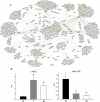Impact of microRNAs on regulatory networks and pathways in human colorectal carcinogenesis and development of metastasis
- PMID: 23987127
- PMCID: PMC3766699
- DOI: 10.1186/1471-2164-14-589
Impact of microRNAs on regulatory networks and pathways in human colorectal carcinogenesis and development of metastasis
Abstract
Background: Qualitative alterations or abnormal expression of microRNAs (miRNAs) in colon cancer have mainly been demonstrated in primary tumors. Poorly overlapping sets of oncomiRs, tumor suppressor miRNAs and metastamiRs have been linked with distinct stages in the progression of colorectal cancer. To identify changes in both miRNA and gene expression levels among normal colon mucosa, primary tumor and liver metastasis samples, and to classify miRNAs into functional networks, in this work miRNA and gene expression profiles in 158 samples from 46 patients were analysed.
Results: Most changes in miRNA and gene expression levels had already manifested in the primary tumors while these levels were almost stably maintained in the subsequent primary tumor-to-metastasis transition. In addition, comparing normal tissue, tumor and metastasis, we did not observe general impairment or any rise in miRNA biogenesis. While only few mRNAs were found to be differentially expressed between primary colorectal carcinoma and liver metastases, miRNA expression profiles can classify primary tumors and metastases well, including differential expression of miR-10b, miR-210 and miR-708. Of 82 miRNAs that were modulated during tumor progression, 22 were involved in EMT. qRT-PCR confirmed the down-regulation of miR-150 and miR-10b in both primary tumor and metastasis compared to normal mucosa and of miR-146a in metastases compared to primary tumor. The upregulation of miR-201 in metastasis compared both with normal and primary tumour was also confirmed. A preliminary survival analysis considering differentially expressed miRNAs suggested a possible link between miR-10b expression in metastasis and patient survival. By integrating miRNA and target gene expression data, we identified a combination of interconnected miRNAs, which are organized into sub-networks, including several regulatory relationships with differentially expressed genes. Key regulatory interactions were validated experimentally. Specific mixed circuits involving miRNAs and transcription factors were identified and deserve further investigation. The suppressor activity of miR-182 on ENTPD5 gene was identified for the first time and confirmed in an independent set of samples.
Conclusions: Using a large dataset of CRC miRNA and gene expression profiles, we describe the interplay of miRNA groups in regulating gene expression, which in turn affects modulated pathways that are important for tumor development.
Figures



References
Publication types
MeSH terms
Substances
LinkOut - more resources
Full Text Sources
Other Literature Sources
Medical
Molecular Biology Databases

